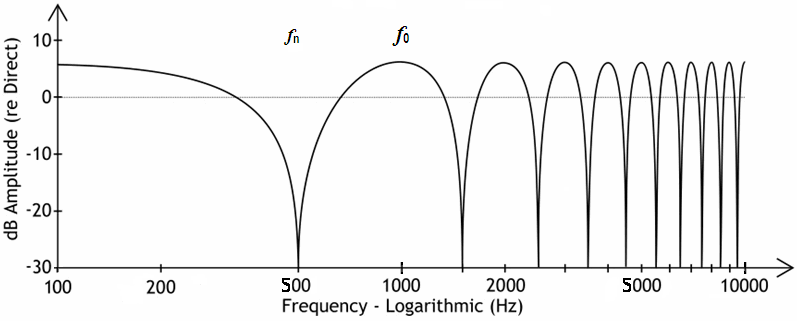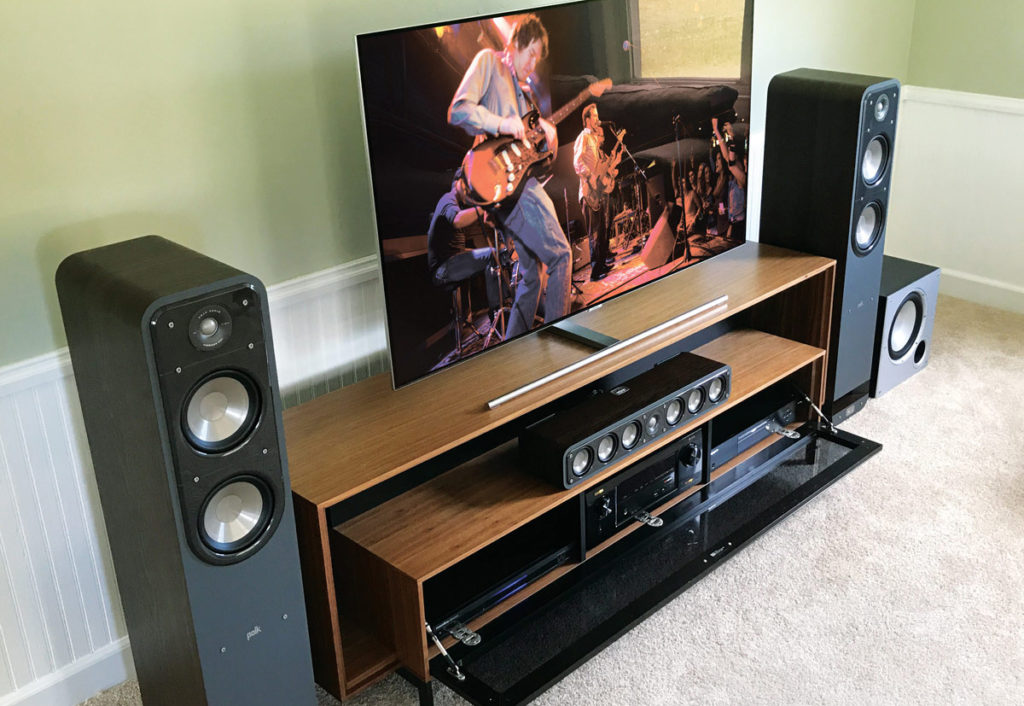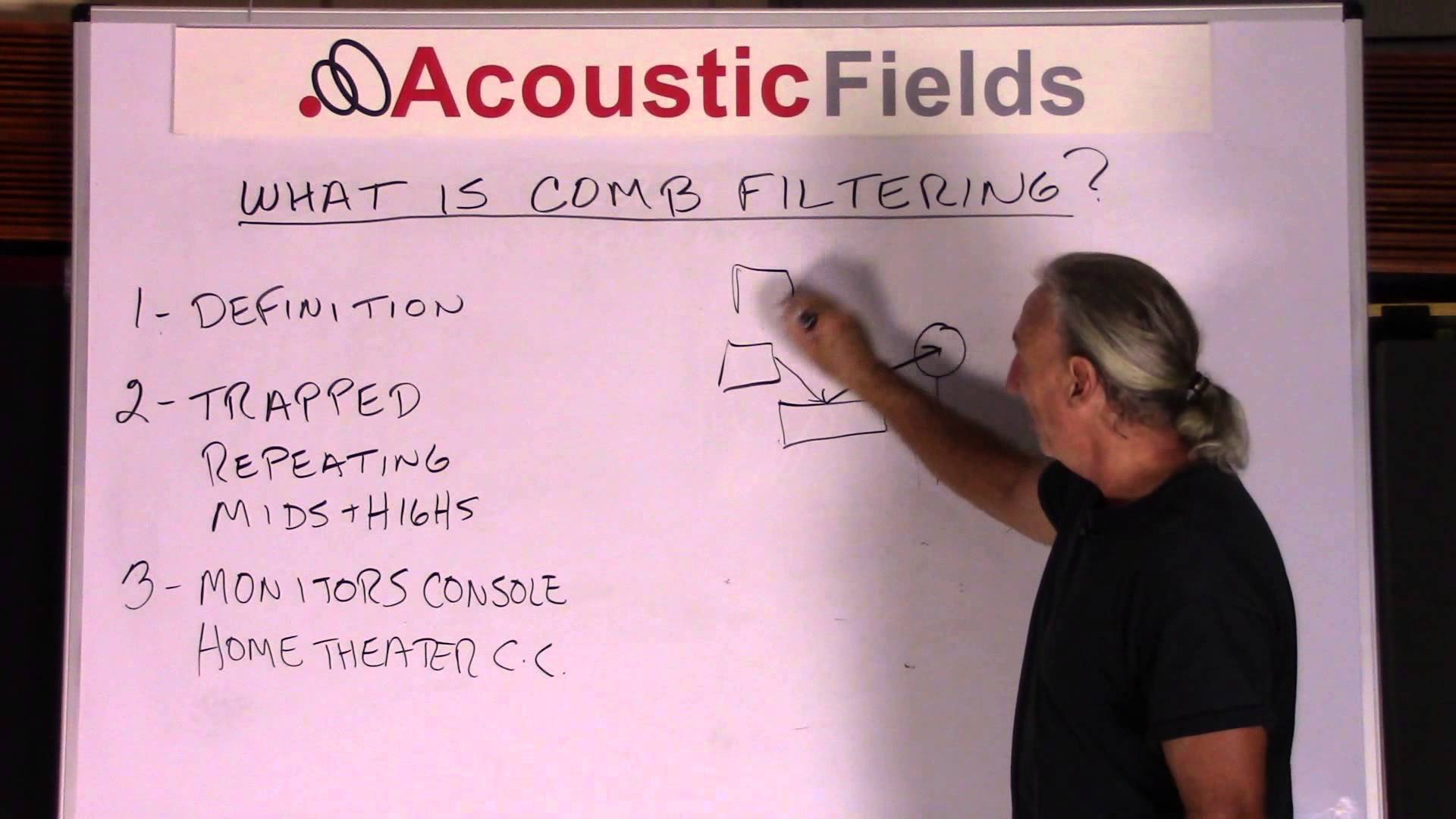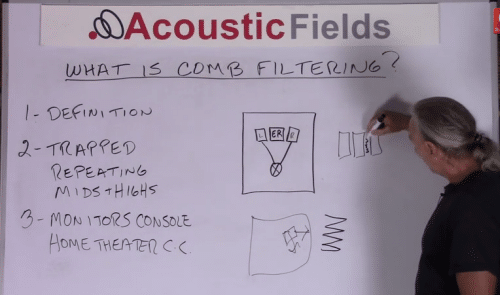Today we’re going to talk about comb filtering. It comes up a lot. I see a lot of it in the drawings and photos that you send in so I think it’s something we need to address. We have updated this blog to reflect the current science on 11/18/19. What is comb filtering?.
What is comb filtering?
Comb Filtering is a series of unwanted reflections between a speaker, or a sound-producing device, and a boundary surface or any surface. It’s a series of back and forth reflections that are trapped mainly from middle and high frequencies. If you look at this distortion on a graph it looks like the teeth of a comb. Let’s use an example to illustrate this point.
Comb Filtering: https://en.wikipedia.org/wiki/Comb_filter

dB Frequency vs. Amplitude
I see a lot of hi-fi systems with left and right two-channel systems and then in the middle, they’ll have an equipment rack. The equipment rack will be just as high as their speakers. An equipment rack is a solid object All of this area between the equipment rack and the speakers is producing a series of back-and-forth reflections. These reflections repeat themselves since they are trapped between the speakers and the equipment rack. These back and forth reflections create audible distortion. Do you really want more noise at your listening position because of all this interference going on between your speakers and your equipment rack?
Sidewalls
The same thing is true for the sidewalls. You have to be very careful with those distances. You can’t have anything between your speakers and the distances to each sidewall from the left and right sidewalls must be equal. If you must place your equipment between the speakers, keep it as low as possible, no more than 12″ off the floor. You don’t want any reflections striking the equipment, bouncing against the speakers and then producing distortion that’s then added to your room sound.
We have so many variables people want to know what is comb filtering? Once we define it we have to control it. It’s called a comb filter because it looks like the teeth of a comb and that’s that zigzag pattern that you see all the time. That’s a series of reflections moving back and forth and it will produce noise and it will produce a phantom image and that’s the last thing you want. You sure don’t want anything competing with the energy from your speakers. We’re doing our best to minimize room sound and hear more of the sound from our speakers so the last thing that you want to do is add comb filtering to the process.
Reflection vs. Refraction: https://www.physicsclassroom.com/class/sound/Lesson-3/Reflection,-Refraction,-and-Diffraction
Examples of comb filtering in a recording studio
Let’s look at some examples in real life that we see all the time. You will have to deal with and one of those examples at some point in your audio career especially in the professional world. One of the largest comb filtering offenders is the console. It’s a fact of life that we have to have a console It’s a fact of life we have to have a monitor and it’s a fact of life that we have to sit at that listening position and listen. What happens is the energy from the speaker strikes the console and then it comes back into our ears. This is also a time delay issue because the reflection has a time signature. It has time signatures to it but also remembers sound takes on the characteristics of the surfaces that it strikes so you’re going to get, forgive me for saying this, “console sound” back at the listening or monitoring position. We need to elevate the monitor, change the angle of attack, so we reduce this kind of situation.
Examples of comb filtering in a home theater
Where else do we see it? We see it in home theater applications with that dreaded center channel. We all see that center channel in home theaters. Where is that usually located? It’s usually on the floor. What’s the first thing that the energy from the center channel strikes? It strikes the floor. It is positioned so close to the floor that comb filtering results. Comb filtering is an audible distortion. Secondly, most center channel speakers are positioned in the horizontal dispersion sound field. The right and left channels are vertically positioned and spread their energy out in a vertical and horizontal sound field. This is another example of audible distortion.

Vertical Left and Right – Horizontal Center
We have the direct energy from the speaker and then we have all these reflections, or comb filtering, off the floor. These interference patterns are competing with direct energy. We’re not a big proponent of center channels. We split the signal from center channels and we use a whole other set of speakers for it. So you’ll have center-left, center-right, you’ll have right and you’ll have left. Because this array puts all the energy in a straight horizontal plane, you don’t have any horizontal dispersion and vertical dispersion so you get all your energy with this. We’re not a big proponent of center channel speaker simply because of the comb filtering effect that we hear. Set up using a left channel then a left-center channel then a right channel and a right-center. Keep all four channels in the vertical dispersion array.
In Summary
I hope this discussion helped. Feel free to contact me directly at: 520 – 392 – 9486 MST or info@acousticfields.com. If you would like to learn more about room acoustics please sign up for my free videos and ebook by joining the mailing list here.
Thanks and speak soon,
Dennis








